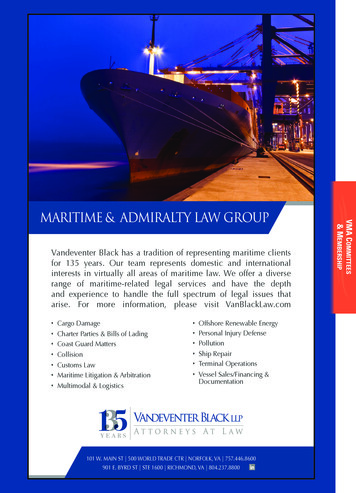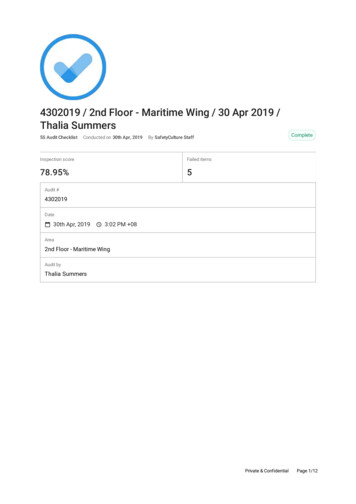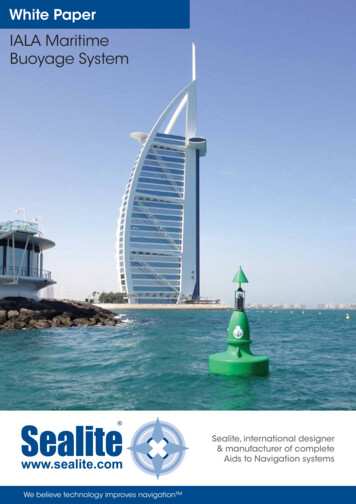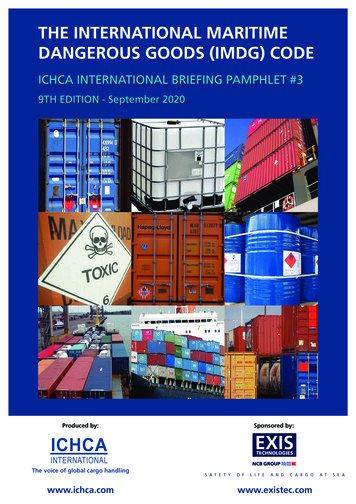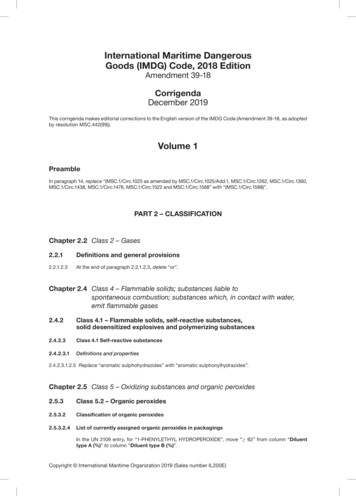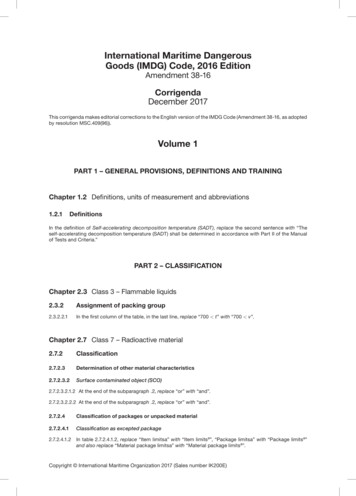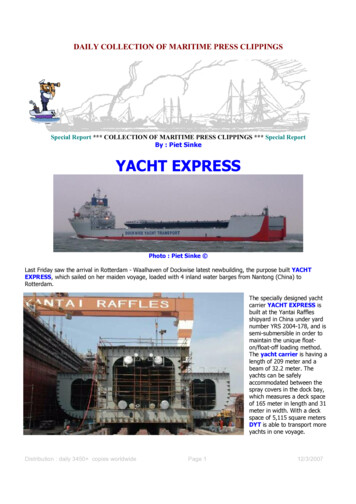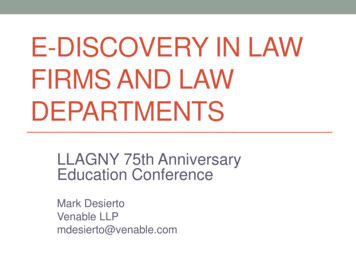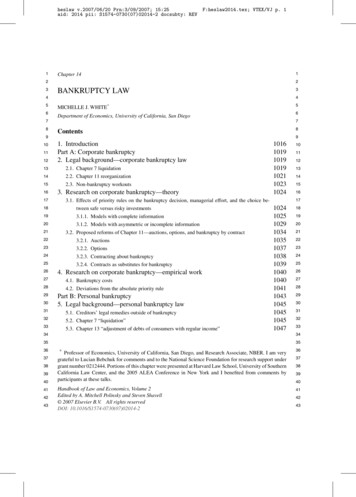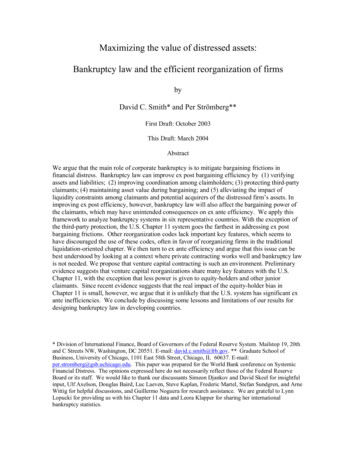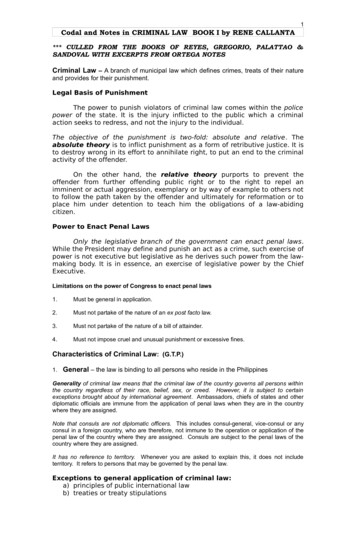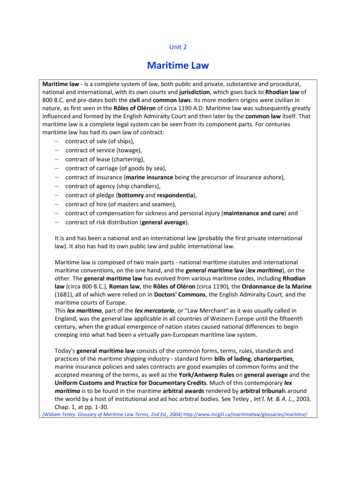
Transcription
Unit 2Maritime LawMaritime law - is a complete system of law, both public and private, substantive and procedural,national and international, with its own courts and jurisdiction, which goes back to Rhodian law of800 B.C. and pre-dates both the civil and common laws. Its more modern origins were civilian innature, as first seen in the Rôles of Oléron of circa 1190 A.D. Maritime law was subsequently greatlyinfluenced and formed by the English Admiralty Court and then later by the common law itself. Thatmaritime law is a complete legal system can be seen from its component parts. For centuriesmaritime law has had its own law of contract: contract of sale (of ships), contract of service (towage), contract of lease (chartering), contract of carriage (of goods by sea), contract of insurance (marine insurance being the precursor of insurance ashore), contract of agency (ship chandlers), contract of pledge (bottomry and respondentia), contract of hire (of masters and seamen), contract of compensation for sickness and personal injury (maintenance and cure) and contract of risk distribution (general average).It is and has been a national and an international law (probably the first private internationallaw). It also has had its own public law and public international law.Maritime law is composed of two main parts - national maritime statutes and internationalmaritime conventions, on the one hand, and the general maritime law (lex maritima), on theother. The general maritime law has evolved from various maritime codes, including Rhodianlaw (circa 800 B.C.), Roman law, the Rôles of Oléron (circa 1190), the Ordonnance de la Marine(1681), all of which were relied on in Doctors' Commons, the English Admiralty Court, and themaritime courts of Europe.This lex maritima, part of the lex mercatoria, or "Law Merchant" as it was usually called inEngland, was the general law applicable in all countries of Western Europe until the fifteenthcentury, when the gradual emergence of nation states caused national differences to begincreeping into what had been a virtually pan-European maritime law system.Today's general maritime law consists of the common forms, terms, rules, standards andpractices of the maritime shipping industry - standard form bills of lading, charterparties,marine insurance policies and sales contracts are good examples of common forms and theaccepted meaning of the terms, as well as the York/Antwerp Rules on general average and theUniform Customs and Practice for Documentary Credits. Much of this contemporary lexmaritima is to be found in the maritime arbitral awards rendered by arbitral tribunals aroundthe world by a host of institutional and ad hoc arbitral bodies. See Tetley , Int'l. M. & A. L., 2003,Chap. 1, at pp. 1-30.(William Tetley. Glossary of Maritime Law Terms, 2nd Ed., 2004) me/
Ex. 1Pair work. Consider the following terms below and write down your ideas of theirmeaning. Then discuss your ideas with your partner.-public vs private law:substantive vs procedural law:national vs international law:civil vs common law:jurisdiction:Ex. 2Group work. Check the meaning(s) of the same legal terms above in any online dictionary(general English or English dictionary of law), compare the definitions with you ideas andthen discuss your findings within your group. Find your own language equivalents for theterms below.-public vs private law:substantive vs procedural law:national vs international law:civil vs common law:jurisdiction:Ex. 3Answer the following questions:1.2.3.4.5.6.7.8.9.10.Why is maritime law a system of its own (an independent law)? – two reasons:What are the two laws by which maritime law was greately influenced in the history?What is the meaning of the word 'statute' in the term national maritime statute. Consultonline general and legal dictionaries or definitions on the web.Why is there no 'pan-European' maritime law system today?What does general maritime law consist of? -(five constituent parts: .). Discuss eachconstituent part and give their equivalents in your language.What are the most common forms of maritime law? - . (four forms). Chechyour ideas of these forms in your group.Consult your dictionaries for the meaning of the word 'award' and then define the term'arbitral award'?Check the synonyms for the word 'host' in the phrase 'host of arbitral bodies'.Discuss the ideas on the difference between 'lex maritima' and 'lex mercatoria' in your group.What is their relationship?What do the individual contracts of maritime law deal with?
Admiralty law or maritime law is a distinct body of law that governs maritime questions andoffenses. It is a body of both domestic law governing maritime activities, and privateinternational law governing the relationships between private entities that operate vessels onthe oceans. It deals with matters including marine commerce, marine navigation, marinesalvaging, shipping, sailors, and the transportation of passengers and goods by sea. Admiraltylaw also covers many commercial activities, although land based or occurring wholly on land,that are maritime in character.Admiralty law is distinguished from the Law of the Sea, which is a body of publicinternational law dealing with navigational rights, mineral rights, jurisdiction over coastalwaters and international law governing relationships between nations.Maritime law consists of a body of laws, conventions and treaties that governs internationalprivate business or other matters involving ships, shipping or crimes occurring on open water.Laws between nations governing such things as national versus international waters areconsidered public international law and are known as the Law of the Seas.In most developed nations, maritime law is governed by a separate code and is a separatejurisdiction from national laws. The United Nations, through the International MaritimeOrganization, has issued numerous conventions that can be enforced by the navies and coastguards that have signed the treaty outlining these rules. Maritime law governs many of theinsurance claims relating to ships and cargo, civil matters between shipowners, seamen andpassengers, and piracy.http://en.wikipedia.org/wiki/Admiralty lawEx. 4Supply the missing word/term (given in brackets at the end of each passage):Admiralty law or maritime law is a distinct body of law that governs maritimequestions and . It is a body of both domestic law governing maritimeactivities, and private international law governing the relationships between privatethat operate vessels on the oceans. It deals with matters includingmarine commerce, marine navigation, marine , shipping, sailors, andthe transportation of passengers and goods by sea. law also coversmany commercial activities, although land based or occurring wholly on land, that aremaritime in character. (salvaging, offences, Admiralty, entities)Admiralty law is distinguished from the Law of the , which is a body ofpublic international law dealing with navigational rights, mineral rights,over coastal waters and international law governing between nations.(relationships Sea, jurisdiction)Maritime law consists of a body of , conventions andthat governs international private business or other matters involving ships,or crimes occurring on open water. Laws between nations governing
such things as national versus international waters are consideredinternational law and are known as the Law of the Seas. (treaties, laws, public,treaties, shipping)Ex. 5Complete the sentences below:1. Admiralty law or maritime law is a distinct body of law that governs . .2. It is a body of both domestic law governing ., and privateinternational law governing . that operate vessels on the oceans.3. It deals with matters including marine commerce, marine navigation, marinesalvaging, shipping, sailors, and . .4. Admiralty law is distinguished from the Law of the Sea, which is a body of publicinternational law dealing with ., ., jurisdiction. and international law governing . .5. Maritime law consists of a body of . that governs internationalprivate business or other matters involving ships, shipping or . .6. Laws between nations governing such things as national versus international watersare considered public international law and are known as . .
Features of admiralty lawhttp://en.wikipedia.org/wiki/Admiralty law1. Maintenance and cureThe doctrine of maintenance and cure is rooted in the Article VI of the Rolls of Oleronpromulgated in about 1160 A.D. The obligation to "cure" requires a shipowner to providemedical care, free of charge, to a seaman injured in the service of the ship, until the seamanhas reached "maximum medical cure". The obligation to "cure" a seaman includes theobligation to provide him with medications and medical devices which improve his ability tofunction, even if they don't "improve" his actual condition. They may include long termtreatments that permit him to continue to function well. Common examples includeprostheses, wheelchairs, and pain medications.The obligation of "maintenance" requires the shipowner to provide a seaman with his basicliving expenses while he is convalescing. Once a seaman is able to work, he is expected tomaintain himself. Consequently, a seaman can lose his right to maintenance, while theobligation to provide cure is ongoing.2. Personal injuries to passengersShipowners owe a duty of reasonable care to passengers. Consequently, passengers who areinjured aboard ships may bring suit as if they had been injured ashore through the negligenceof a third party. The passenger bears the burden of proving that the shipowner was negligent.While the statute of limitations is generally three years, suits against cruise lines must usuallybe brought within one year because of limitations contained in the passenger ticket.3. Maritime liens and mortgagesBanks which loan money to purchase ships, vendors who supply ships with necessaries likefuel and stores, seamen who are due wages, and many others have a lien against the ship toguarantee payment. To enforce the lien, the ship must be arrested or seized.4. Salvage and treasure salvageWhen property is lost at sea and rescued by another, the rescuer is entitled to claim a salvageaward on the salved property. There is no "life salvage". All mariners have a duty to save thelives of others in peril without expectation of reward. Consequently salvage law applies onlyto the saving of property.There are two types of salvage: contract salvage and pure salvage, which is sometimesreferred to as "merit salvage". In contract salvage the owner of the property and salvor enterinto a salvage contract prior to the commencement of salvage operations and the amount thatthe salvor is paid is determined by the contract. The most common salvage contract is called a"Lloyd's Open Form Salvage Contract“.
Ex. 6Known, partly known and unknown words. Read the above text and note downwords into the following columns. Exchange views about these words in yourgroup.These words are familiarto meI only partly know theword; I am not sure of itsmeaningI have never seen or heardof this wordEx. 7Supply the missing words:Maintenance and cureThe doctrine of maintenance and is rooted in the Article VI of the Rollsof Oleron promulgated in about 1160 A.D. The obligation to "cure" requires ashipowner to provide , free of charge, to a seaman in theservice of the ship, until the seaman has reached "maximum medical cure". Theobligation to "cure" a seaman includes the obligation to provide him withand medical devices which improve his ability to function, even if they don't"improve" his actual condition. They may include long term that permithim to continue to function well. Common examples include prostheses, wheelchairs,and pain .The obligation of "maintenance" requires the shipowner to provide a seaman with hisbasic while he is convalescing. Once a seaman is able to work, he isexpected to himself. Consequently, a seaman can lose his right tomaintenance, while the obligation to provide cure is .Ex. 8Supply the missing verb collocate in the text below:1. Maintenance and cureThe doctrine of maintenance and cure is rooted in the Article VI of the Rolls of Oleronin about 1160 A.D. The obligation to "cure" requires a shipowner tomedical care, free of charge, to a seaman injured in the service of theship, until the seaman has "maximum medical cure". The obligation to"cure" a seaman includes the obligation to provide him with medications and medical
devices which his ability to function, even if they don't "improve" hisactual condition. They may include long term treatments that him tocontinue to function well.The obligation of "maintenance" requires the shipowner to a seamanwith his basic living expenses while he is convalescing. Once a seaman is able to work,he is expected to maintain himself. Consequently, a seaman can hisright to maintenance, while the obligation to provide cure is ongoing.2. Personal injuries to passengersShipowners a duty of reasonable care to passengers. Consequently,passengers who are injured aboard ships may suit as if they had beeninjured ashore through the negligence of a third party. The passengerthe burden of proving that the shipowner was negligent. While the statute of limitations isgenerally three years, suits against cruise lines must usually be withinone year because of limitations contained in the passenger ticket.3. Maritime liens and mortgagesBanks which money to purchase ships, vendors who supply ships withnecessaries like fuel and stores, seamen who are due wages, and many othersa lien against the ship to guarantee payment. To thelien, the ship must be or seized.4. Salvage and treasure salvageWhen property is lost at sea and rescued by another, the rescuer is entitled toa salvage award on the salved property. There is no "life salvage". Allmariners have a duty to the lives of others in peril without expectation ofreward. Consequently salvage law only to the saving of property.There are two types of salvage: contract salvage and pure salvage, which is sometimesreferred to as "merit salvage". In contract salvage the owner of the property and salvorinto a salvage contract prior to the commencement of salvageoperations and the amount that the salvor is paid is determined by the contract. The mostcommon salvage contract is called a "Lloyd's Open Form Salvage Contract“.Ex. 9Find translation equivalents in your language for the terms highlighted in yellowcolour. Consult monolingual and bilingual general English dictionaries and maritimelaw dictionaries.
1. Maintenance and cureThe doctrine of maintenance and cure is rooted in the Article VI of the Rolls of Oleron promulgatedin about 1160 A.D. The obligation to "cure" requires a shipowner to provide medical care, free ofcharge, to a seaman injured in the service of the ship, until the seaman has reached "maximummedical cure". The obligation to "cure" a seaman includes the obligation to provide him withmedications and medical devices which improve his ability to function, even if they don't "improve"his actual condition. They may include long term treatments that permit him to continue to functionwell. Common examples include prostheses, wheelchairs, and pain medications.The obligation of "maintenance" requires the shipowner to provide a seaman with his basic livingexpenses while he is convalescing. Once a seaman is able to work, he is expected to maintainhimself. Consequently, a seaman can lose his right to maintenance, while the obligation to providecure is ongoing.2. Personal injuries to passengersShipowners owe a duty of reasonable care to passengers. Consequently, passengers who areinjured aboard ships may bring suit as if they had been injured ashore through the negligence of athird party. The passenger bears the burden of proving that the shipowner was negligent. Whilethe statute of limitations is generally three years, suits against cruise lines must usually be broughtwithin one year because of limitations contained in the passenger ticket.3. Maritime liens and mortgagesBanks which loan money to purchase ships, vendors who supply ships with necessaries like fueland stores, seamen who are due wages, and many others have a lien against the ship toguarantee payment. To enforce the lien, the ship must be arrested or seized.4. Salvage and treasure salvageWhen property is lost at sea and rescued by another, the rescuer is entitled to claim a salvageaward on the salved property. There is no "life salvage". All mariners have a duty to save the livesof others in peril without expectation of reward. Consequently salvage law applies only to thesaving of property.There are two types of salvage: contract salvage and pure salvage, which is sometimes referredto as "merit salvage". In contract salvage the owner of the property and salvor enter into a salvagecontract prior to the commencement of salvage operations and the amount that the salvor is paidis determined by the contract. The most common salvage contract is called a "Lloyd's Open FormSalvage Contract“
Components of maritime 0/maritime-law1. Maritime liensAlthough admiralty actions are frequently brought in personam, against individual orcorporate defendants only, the most distinctive feature of admiralty practice is the proceedingin rem, against maritime property, that is, a vessel, a cargo, or “freight,” which in shippingmeans the compensation to which a carrier is entitled for the carriage of cargo.Under American maritime law, the ship is personified to the extent that it may sometimes beheld responsible under circumstances in which the shipowner himself is under no liability.The classic example of personification is the “compulsory pilotage” case. Some state statutesimpose a penalty on a shipowner whose vessel fails to take a pilot when entering or leavingthe waters of the state.Maritime liens can arise not only when the personified ship is charged with a maritime tort1,such as a negligent collision or personal injury, but also for salvage services, for generalaverage contributions, and for breach of certain maritime contracts.In a proceeding in rem, the vessel, cargo, or freight can be arrested and kept in the custody ofthe court unless the owner obtains its release by posting a bond or such other security as maybe required under the applicable law or as may be acceptable to the plaintiff. More frequently,however, the owner will post security to avoid a threatened arrest, and the property never hasto be taken into custody.Ex. 10Supply the missing words or phrases in the right place and in the correct form2. Maritime liensAlthough admiralty are frequently in personam, against individual or corporate defendants only,the most distinctive feature of admiralty practice is the proceeding in rem, against maritimeproperty, that is, a vessel, a cargo, or “freight,” which in shipping means the compensation towhich a carrier is for the carriage of cargo. (bring action, entitle)Under American maritime law, the ship is personified it may sometimes be held responsible undercircumstances in which the shipowner himself is. The classic example of personification is the“compulsory pilotage” case. Some state statutes a shipowner whose vessel fails to take a pilotwhen entering or leaving the waters of the state. (against maritime property, against maritimeproperty, against maritime property)1tort, in common law, civil law, and the vast majority of legal systems that derive from them, anyinstance of harmful behaviour, such as physical attack on one’s person, interference with one’spossessions, or the use and enjoyment of one’s land, economic interests (under certain conditions),honour, reputation, and privacy. The term derives from Latin tortum, meaning “something twisted,wrung, or crooked.” The concept encompasses only those civil wrongs independent of contracts.
Maritime liens can arise not only when the personified ship is with a maritime tort, such as anegligent collision or personal injury, but also for, for general average contributions, and for ofcertain maritime contracts. (charged, salvage services, breach)In a proceeding in rem, the vessel, cargo, or freight can be arrested and of the court unless theowner obtains its release by or such other security as may be required under the applicable law oras may be acceptable to the. More frequently, however, the owner will to avoid a threatenedarrest, and the property never has to be taken into custody. ( kept in the custody, posting abond, plaintiff, post security)Ex. 11Complete the following sentences:Although admiralty actions are frequently brought in personam, against., the most distinctive feature of admiralty practice is the proceedingin rem, against ., or “freight,” which in shipping means.Under ., the ship is personified to the extent that it may sometimes beheld responsible under circumstances in which the shipowner himself is under no liability. Theclassic example of personification is the “.” case. Some state statutes. whose vessel fails to take a pilot when entering or leaving the waters ofthe state.Maritime liens can arise not only when the personified ship is charged with a maritime tort,such as a ., but also for salvage services, for general averagecontributions, and for .In a proceeding in rem, the vessel, cargo, or freight can be arrested and. unless the owner obtains its release by posting a bond or such. as may be required under the applicable law or as may be acceptable to. . More frequently, however, the owner will post security to ., andthe property never has to be taken into custody.
3. Shipping chartersThe function of ships, other than warships, pleasure craft, and service vessels of various typesis of course transportation of cargoes and passengers.The great majority of the contracts governing the carriage of goods by water are evidencedeither by charter parties or by bills of lading. The term charter party (a corruption of the Latincarta partita, or “divided charter”) is employed to describe three widely differing types ofcontracts relating to the use of vessels owned or controlled by others. Under a “demise” or“bareboat” charter, the shipowner delivers possession of the vessel to the charterer, whoengages the master and crew, arranges for repairs and supplies, and, in general, functions inmuch the same way as an owner during the term of the charter. A much more commonarrangement is the “time” charter, whereunder the shipowner employs the master and crewand the charterer simply acquires the right, within specified limits, to direct the movements ofthe vessel and determine what cargoes are to be carried during the charter period. Under bothdemise and time charters, the charterer pays charter hire for the use of the vessel at a specifieddaily or monthly rate.The third type is the “voyage” charter, which is essentially a contract of affreightment, orcarriage. Most voyage charters provide for the carriage of full cargoes on one voyage or aseries of voyages, but occasionally a charterer contracts for the use of only a portion of thecarrying capacity of the vessel, in which case the governing contract is described as a “space”charter.Under a voyage charter, it is customary for the master or his agent to issue a bill of lading tothe shipper, who is usually the charterer, although as between shipowner and charterer thevoyage charter remains the governing contract of carriage; the bill of lading serves only as areceipt and as a document of title to the goods. Ocean bills of lading are usually in order form;that is, they call for delivery to the order of the shipper or of some other designated party.Such a bill of lading may be negotiated in much the same way as a check, draft, or othernegotiable instrument, which means that a bona fide purchaser of the bill of lading takes itfree and clear of any defects not appearing on its face.A distinctive feature of maritime law is the privilege accorded to a shipowner and certainother persons (such as charterers in some instances) to limit the amount of their liability,under certain circumstances, in respect of tort and some contract claims. In some countries,including the United States, the limit, except as to claims for personal injury and wrongfuldeath, is the value of the ship and the earnings of the voyage on which it was engaged at thetime of the casualty. On the other hand, in the United Kingdom and the other countries thathave ratified the Brussels limitation of liability convention of 1957 or enacted domesticlegislation embracing its terms, the limit is 28, or its equivalent, multiplied by the adjustednet tonnage of the vessel, regardless of its actual value.
Ex. 12Match the following sentences in the two columns (Shipping charters)1. The term charter party (a corruption ofthe Latin carta partita, or “dividedcharter”)2. Under a “demise” or “bareboat” charter,the shipowner delivers possession of thea. functions in much the same way as anowner during the term of the charter.b. is employed to describe three widelydiffering types of contracts relating to theuse of vessels owned or controlled byothers.vessel to the charterer, who engages themaster and crew, arranges for repairsc.and supplies, and, in general,3. Under the time charter the shipowneremploys the master and crew and4. Under both demise and time charters,the charterer paysthe charterer simply acquires the right,within specified limits, to direct themovements of the vessel and determinewhat cargoes are to be carried during thecharter period.d. limit the amount of their liability, undercertain circumstances, in respect of tortand some contract claims.5. Most voyage charters provide for thecarriage ofe. charter hire for the use of the vessel at aspecified daily or monthly rate.6. Under a voyage charter, it is customaryfor the master or his agent to7. A distinctive feature of maritime law isthe privilege accorded to a shipownerand certain other persons (such ascharterers in some instances) tof.full cargoes on one voyage or a series ofvoyages, but occasionally a charterercontracts for the use of only a portion ofthe carrying capacity of the vesselg. issue a bill of lading to the shipper, who isusually the charterer1b
4. Collision liabilityUnder maritime law responsibility for collision damage is based upon the fault principle: acolliding vessel will not be held responsible for damage to another ship or to a fixed objectsuch as a bridge, wharf, or jetty unless the collision is caused by a deficiency in the collidingvessel or by negligence or a willful act on the part of its navigators. It is not always necessary,however, to establish fault by positive evidence; there is a presumption of fault when amoving vessel collides with a fixed object or with another vessel that is properly moored oranchored, and the burden of proving freedom from fault will lie with the moving vessel.In countries that have adopted the International Convention for the Unification of CertainRules Relating to Collisions between Vessels, signed at Brussels in 1910, the rule of“comparative negligence” governs: if each of two colliding vessels is to blame, the totaldamages will be divided between their owners or operators in proportion to the respectivedegrees of fault. In certain countries that have not ratified the Convention, such as the UnitedStates, the law is such that, if both vessels are to blame, the total damages are equally divided,regardless of the respective degrees of fault.Ex. 13Group work. Discuss the following terms:-the fault principledeficiencynegligencewillful actpresumption of faultburden of provingto blameEx. 14Cloze. Supply the missing words (every fifth word is missing)Collision liabilityUnder maritime law responsibility collision damage is based the fault principle: avessel will not be responsible for damage to ship or to a object suchas a , wharf, or jetty unless collision is caused by deficiency in the collidingor by negligence or willful act on the of its navigators. It not alwaysnecessary, however, to establish fault by evidence; there is a of fault when avessel collides with a object or with another that is properly mooredanchored, and the burden of proving freedom from fault will lie with themoving vessel.Ex. 15Where are the two rules below applied? What are the key phrases expressing the difference?-if each of two colliding vessels is to blame, the total damages will be divided between theirowners or operators in proportion to the respective degrees of fault:if both vessels are
Unit 2 Maritime Law Maritime law - is a complete system of law, both public and private, substantive and procedural, national and international, with its own courts and jurisdiction, which goes back to Rhodian law of 800 B.C. and pre-dates both the civil
